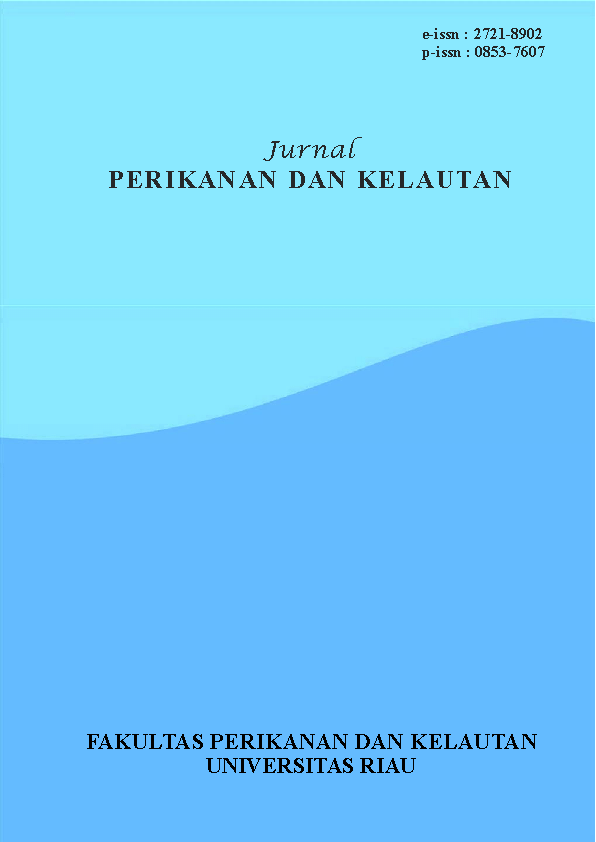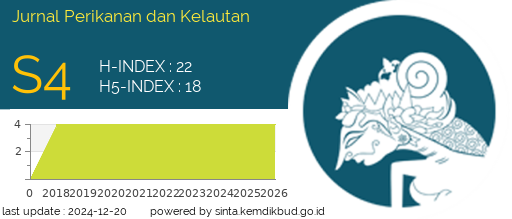Analysis of Business Financing of Capture Fishermen from Non-Formal Sources in Kuala Indragiri Sub-District, Indragiri Hilir District, Riau Province
DOI:
https://doi.org/10.31258/jpk.29.3.423-430Keywords:
Socio-economic Conditions, Funding, Decision to BorrowAbstract
Funding for fishermen's enterprises refers to the costs fishermen require to procure investment goods and operational costs for fishing activities. Funding for fishermen's enterprises is sourced from various channels. This research was conducted in May 2024 in Kuala Indragiri District, Indragiri Hilir Regency, Riau Province. The research has two objectives: first, to describe the procedures for funding fishermen's enterprises. The second objective is to determine the influence of funding procedures and the socio-economic conditions of fishermen on the decision to borrow from non-formal sources. The sample consisted of 79 fishermen from 3 villages selected using the purposive sampling. Data collection was done through interviews, documentation, and questionnaires. Data analysis was conducted using Descriptive Analysis and Multiple Linear Regression. The results of the descriptive analysis show that the procedures for funding fishermen's enterprises can be sourced from self-funding, family, and non-formal sources referred to as "container", with a value of 3.94 categorized as easy. The multiple linear regression analysis results yielded the equation Ŷ = 17.465 + 0.477X1 - 0.306X2. The research results indicate that funding procedures positively and significantly impact the decision to borrow from non-formal sources. Meanwhile, socio-economic conditions negatively and significantly affect the decision to borrow from non-formal sources. There is a positive and significant simultaneous influence between funding procedures and socio-economic conditions on borrowing from non-formal sources. The variable model can predict borrowing decisions from non-formal sources by 52.2%, with 47.8% influenced by other variables
Downloads
References
[BPS] Bps.go.id. (2022). Banyak Armada dan/Kapal Perikanan di Kabupaten Indragiri Hilir. In bps.go.id. https://inhilkab.bps.go.id/statictable/2016/08/30/106/banyak-armada-dan-kapal-perikanan-di-kabupaten-indragiri-hilir-2015.html
Bathara, L., Yanti, C.W., & Metalisa, R. (2021). Analysis of Financing Structure of Sea Fisherman Business (Duano Tribe) in Tanjung Pasir Village, Indragiri Hilir. Berkala Perikanan Terubuk, 49(3): 1343–1352.
Cahyadi, M.A., & Diatmika, I.P.G. (2021). Pengaruh Layanan, Prosedur Kredit dan Promosi terhadap Keputusan UMKM Melakukan Pinjaman Kredit pada Lembaga Keuangan Bukan Bank (LKBB) di Kecamatan Buleleng. JIMAT (Jurnal Ilmiah Mahasiswa Akuntansi) Undiksha, 1: 895–905.
Gherghina, Ș.C., Botezatu, M.A., Hosszu, A., & Simionescu, L.N. (2020). Small and Medium-Sized Enterprises (SMEs): The Engine of Economic Growth Through Investments and Innovation. Sustainability, 12(1): 347
Ghozali, I. (2018). Aplikasi Analisis Multivariate dengan Program IBM SPSS 25. Semarang: Badan Penerbit Universitas Diponegoro
Hamdani, H., Puspita, D., Farmiati, J., Murhadi, T., Arfan, R., & Heppy, H. (2020). Pemberdayaan Pelaku Usaha Pengolahan Perikanan Menuju UMKM Naik Kelas. Community Development Journal : Jurnal Pengabdian Masyarakat, 1(3),
Isamuddin, I. (2014). Pembiayaan Usaha Perikanan Tangkap di Pelabuhan Perikanan Samudera (PPS) Nizam Zachman. Jakarta. Institut Pertanian Bogor Bogor.
Julita, S.P., Idwal, I., & Hasanah, U. (2024). Pengaruh Keadaan Ekonomi dan Pelayanan terhadap Keputusan Berhutang dengan Sistem Bunga (Riba). Journal of Economic, Business and Accounting (COSTING), 7(4): 7691–7699.
Kotler, P. (2010). Manajemen Pemasaran. Edisi tiga belas Bahasa Indonesia. Jilid 1 dan 2. Jakarta: Erlangga
Kuncoro, K., Mudrajad, M., & Suhardjono, S. (2002). Manajemen Perbankan Teori dan Aplikasi. Yogyakarta: BPFE
Leach, J.C. & Melicher, R.W. (2021). Entrepreneurial Finance. 07. Boston: Cengage Learning.
Mita, L.A., & Rahaju, J. (2023). Analisis Sistem Perkreditan dan Pembiayaan Pola Pengambe’ pada Wirausaha Penangkapan Ikan Skala Kecil di Muncar Jawa Timur. Jurnal Pendidikan dan Kewirausahaan, 11(2): 577–598.
Nadjib, M. (2013). Sistem Pembiayaan Nelayan. LIPI Press.
Nadjib, M., & Thoha, M. (2023). Model Kredit untuk Nelayan: Konstruksi atas Sifat Usaha dan Budaya Ekonomi. Ekonomi dan Pembangunan, 31(2): 143–162.
Ningsih, S., & Dukalang, H.H. (2019). Penerapan Metode Suksesif Interval pada Analsis Regresi Linier Berganda. Jambura Journal of Mathematics, 1(1), 43–53.
Salsabilla, I.I., Jannah, E., & Juanda, J. (2023). Analisis Modul Ajar Berbasis Kurikulum Merdeka. Jurnal Literasi dan Pembelajaran Indonesia, 3(1): 33–41.
Sugiyono, S. (2013). Metode Penelitian Kuantitatif dan Kualitatif dan R&D. Bandung: Alfabeta
Suleman, A., Pratiknjo, M.H., & Sandiah, N. (2019). Kemiskinan Struktural dan Hubungan Patron Klien Nelayan di Desa Maitara Kecamatan Tidore Utara Kota Tidore Kepulauan. Jurnal Holistik, 12(2): 1–20.
Varga, J. (2021). Defining the Economic Role and Benefits of Micro Small, and Medium-sized Enterprises in the 21st Century with a Systematic Review of the Literature. Acta Polytechnica Hungarica, 18(11): 209–228
Yulinda, E., Hendri, R., & Yolandika, C. (2023). The Role of Trust Mediation in the Effect of Business Capital, Production Factors and Government Support on the Marine Fish Supply Chain Performance, in Inhil Riau, Indonesia. AACL Bioflux, 16(1): 291–298








